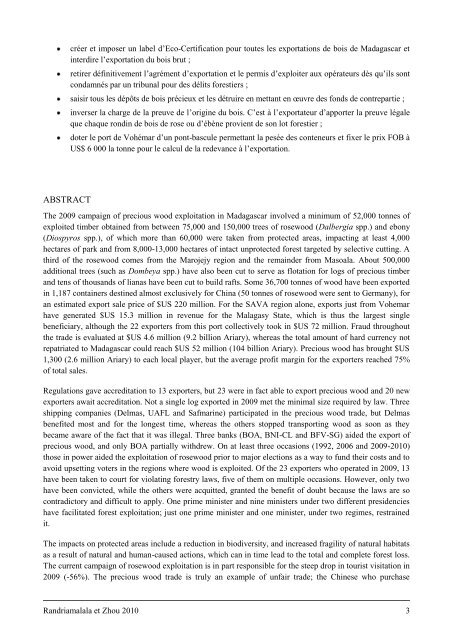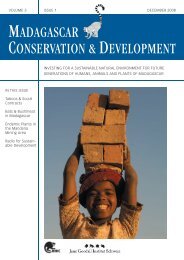Bois de rose de Madagascar - Madagascar Wildlife Conservation
Bois de rose de Madagascar - Madagascar Wildlife Conservation
Bois de rose de Madagascar - Madagascar Wildlife Conservation
You also want an ePaper? Increase the reach of your titles
YUMPU automatically turns print PDFs into web optimized ePapers that Google loves.
ABSTRACT<br />
créer et imposer un label d‘Eco-Certification pour toutes les exportations <strong>de</strong> bois <strong>de</strong> <strong>Madagascar</strong> et<br />
interdire l‘exportation du bois brut ;<br />
retirer définitivement l‘agrément d‘exportation et le permis d‘exploiter aux opérateurs dès qu‘ils sont<br />
condamnés par un tribunal pour <strong>de</strong>s délits forestiers ;<br />
saisir tous les dépôts <strong>de</strong> bois précieux et les détruire en mettant en œuvre <strong>de</strong>s fonds <strong>de</strong> contrepartie ;<br />
inverser la charge <strong>de</strong> la preuve <strong>de</strong> l‘origine du bois. C‘est à l‘exportateur d‘apporter la preuve légale<br />
que chaque rondin <strong>de</strong> bois <strong>de</strong> <strong>rose</strong> ou d‘ébène provient <strong>de</strong> son lot forestier ;<br />
doter le port <strong>de</strong> Vohémar d‘un pont-bascule permettant la pesée <strong>de</strong>s conteneurs et fixer le prix FOB à<br />
US$ 6 000 la tonne pour le calcul <strong>de</strong> la re<strong>de</strong>vance à l‘exportation.<br />
The 2009 campaign of precious wood exploitation in <strong>Madagascar</strong> involved a minimum of 52,000 tonnes of<br />
exploited timber obtained from between 75,000 and 150,000 trees of <strong>rose</strong>wood (Dalbergia spp.) and ebony<br />
(Diospyros spp.), of which more than 60,000 were taken from protected areas, impacting at least 4,000<br />
hectares of park and from 8,000-13,000 hectares of intact unprotected forest targeted by selective cutting. A<br />
third of the <strong>rose</strong>wood comes from the Marojejy region and the remain<strong>de</strong>r from Masoala. About 500,000<br />
additional trees (such as Dombeya spp.) have also been cut to serve as flotation for logs of precious timber<br />
and tens of thousands of lianas have been cut to build rafts. Some 36,700 tonnes of wood have been exported<br />
in 1,187 containers <strong>de</strong>stined almost exclusively for China (50 tonnes of <strong>rose</strong>wood were sent to Germany), for<br />
an estimated export sale price of $US 220 million. For the SAVA region alone, exports just from Vohemar<br />
have generated $US 15.3 million in revenue for the Malagasy State, which is thus the largest single<br />
beneficiary, although the 22 exporters from this port collectively took in $US 72 million. Fraud throughout<br />
the tra<strong>de</strong> is evaluated at $US 4.6 million (9.2 billion Ariary), whereas the total amount of hard currency not<br />
repatriated to <strong>Madagascar</strong> could reach $US 52 million (104 billion Ariary). Precious wood has brought $US<br />
1,300 (2.6 million Ariary) to each local player, but the average profit margin for the exporters reached 75%<br />
of total sales.<br />
Regulations gave accreditation to 13 exporters, but 23 were in fact able to export precious wood and 20 new<br />
exporters await accreditation. Not a single log exported in 2009 met the minimal size required by law. Three<br />
shipping companies (Delmas, UAFL and Safmarine) participated in the precious wood tra<strong>de</strong>, but Delmas<br />
benefited most and for the longest time, whereas the others stopped transporting wood as soon as they<br />
became aware of the fact that it was illegal. Three banks (BOA, BNI-CL and BFV-SG) ai<strong>de</strong>d the export of<br />
precious wood, and only BOA partially withdrew. On at least three occasions (1992, 2006 and 2009-2010)<br />
those in power ai<strong>de</strong>d the exploitation of <strong>rose</strong>wood prior to major elections as a way to fund their costs and to<br />
avoid upsetting voters in the regions where wood is exploited. Of the 23 exporters who operated in 2009, 13<br />
have been taken to court for violating forestry laws, five of them on multiple occasions. However, only two<br />
have been convicted, while the others were acquitted, granted the benefit of doubt because the laws are so<br />
contradictory and difficult to apply. One prime minister and nine ministers un<strong>de</strong>r two different presi<strong>de</strong>ncies<br />
have facilitated forest exploitation; just one prime minister and one minister, un<strong>de</strong>r two regimes, restrained<br />
it.<br />
The impacts on protected areas inclu<strong>de</strong> a reduction in biodiversity, and increased fragility of natural habitats<br />
as a result of natural and human-caused actions, which can in time lead to the total and complete forest loss.<br />
The current campaign of <strong>rose</strong>wood exploitation is in part responsible for the steep drop in tourist visitation in<br />
2009 (-56%). The precious wood tra<strong>de</strong> is truly an example of unfair tra<strong>de</strong>; the Chinese who purchase<br />
Randriamalala et Zhou 2010 3



